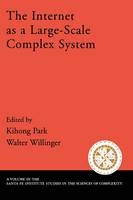
The Internet As a Large-Scale Complex System
Seiten
2005
Oxford University Press Inc (Verlag)
978-0-19-515721-5 (ISBN)
Oxford University Press Inc (Verlag)
978-0-19-515721-5 (ISBN)
The Internet may be viewed as a "complex system" with diverse features and many components that can give rise to unexpected emergent phenomena, revealing much about its own engineering. This book brings together chapter contributions from a workshop held at the Santa Fe Institute in March 2001. This volume captures a snapshot of some features of the Internet that may be fruitfully approached using a complex systems perspective, meaning using interdisciplinary tools and methods to tackle the subject area. The Internet penetrates the socioeconomic fabric of everyday life; a broader and deeper grasp of the Internet may be needed to meet the challenges facing the future.
The resulting empirical data have already proven to be invaluable for gaining novel insights into the network's spatio-temporal dynamics, and can be expected to become even more important when tryin to explain the Internet's complex and emergent behavior in terms of elementary networking-based mechanisms. The discoveries of fractal or self-similar network traffic traces, power-law behavior in network topology and World Wide Web connectivity are instances of unsuspected, emergent system traits. Another important factor at the heart of fair, efficient, and stable sharing of network resources is user behavior. Network systems, when habited by selfish or greedy users, take on the traits of a noncooperative multi-party game, and their stability and efficiency are integral to understanding the overall system and its dynamics. Lastly, fault-tolerance and robustness of large-scale network systems can exhibit spatial and temporal correlations whose effective analysis and management may benefit from rescaling techniques applied in certain physical and biological systems. The present book will bring together several of the leading workers involved in the analysis of complex systems with the future development of the Internet.
The resulting empirical data have already proven to be invaluable for gaining novel insights into the network's spatio-temporal dynamics, and can be expected to become even more important when tryin to explain the Internet's complex and emergent behavior in terms of elementary networking-based mechanisms. The discoveries of fractal or self-similar network traffic traces, power-law behavior in network topology and World Wide Web connectivity are instances of unsuspected, emergent system traits. Another important factor at the heart of fair, efficient, and stable sharing of network resources is user behavior. Network systems, when habited by selfish or greedy users, take on the traits of a noncooperative multi-party game, and their stability and efficiency are integral to understanding the overall system and its dynamics. Lastly, fault-tolerance and robustness of large-scale network systems can exhibit spatial and temporal correlations whose effective analysis and management may benefit from rescaling techniques applied in certain physical and biological systems. The present book will bring together several of the leading workers involved in the analysis of complex systems with the future development of the Internet.
| Erscheint lt. Verlag | 14.7.2005 |
|---|---|
| Reihe/Serie | Santa Fe Institute Studies on the Sciences of Complexity |
| Zusatzinfo | 103 line illus. |
| Verlagsort | New York |
| Sprache | englisch |
| Maße | 234 x 156 mm |
| Gewicht | 454 g |
| Themenwelt | Mathematik / Informatik ► Informatik ► Web / Internet |
| Sozialwissenschaften ► Pädagogik ► Berufspädagogik | |
| Sozialwissenschaften ► Soziologie ► Gender Studies | |
| Wirtschaft ► Betriebswirtschaft / Management | |
| ISBN-10 | 0-19-515721-4 / 0195157214 |
| ISBN-13 | 978-0-19-515721-5 / 9780195157215 |
| Zustand | Neuware |
| Haben Sie eine Frage zum Produkt? |
Mehr entdecken
aus dem Bereich
aus dem Bereich
Handbuch für die Praxis
Buch | Hardcover (2023)
O'Reilly (Verlag)
39,90 €


